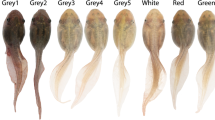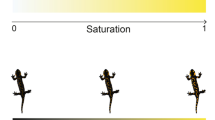Abstract
VARIOUS species of Pisces, Amphibia and Reptilia exhibit reversible colour change according to lighting conditions. According to Parker1, Chelonia is the only order of Reptilia from which no example of this activity has been described. It is the purpose of this communication to record colour change in a tortoise (Chelodina longicolis).
This is a preview of subscription content, access via your institution
Access options
Subscribe to this journal
Receive 51 print issues and online access
$199.00 per year
only $3.90 per issue
Buy this article
- Purchase on Springer Link
- Instant access to full article PDF
Prices may be subject to local taxes which are calculated during checkout
Similar content being viewed by others
References
Parker, G. H., “Animal Colour Changes and their Neurohumours” (Cambridge Univ. Press, 1948).
Hogben, L., Proc. Roy. Soc., B, 131, 111 (1942).
Neill R. M., J. Exp. Biol., 17, 74 (1940).
Hogben, L., “The Pigmentary Effector System” (Oliver and Boyd, London, 1924).
Waring, H., Proc. Roy. Soc., B, 128, 343 (1940).
Burgers, A. C. J., Investigation into the Action of Certain Hormones and other Substances on the Melanophores of the South African Clawed Toad, Xenopus laevis (V. W. Van Der Wiel and Co., Arnhem, 1956).
Waring, H., Biol. Rev., 17, 120 (1942). Young, J. Z., “The Life of Vertebrates” (Clarendon Press, Oxford, 1954).
Author information
Authors and Affiliations
Rights and permissions
About this article
Cite this article
WOOLLEY, P. Colour Change in a Chelonian. Nature 179, 1255–1256 (1957). https://doi.org/10.1038/1791255a0
Issue Date:
DOI: https://doi.org/10.1038/1791255a0
This article is cited by
-
Comparative population genetics of aquatic turtles in the desert
Conservation Genetics (2012)
Comments
By submitting a comment you agree to abide by our Terms and Community Guidelines. If you find something abusive or that does not comply with our terms or guidelines please flag it as inappropriate.



